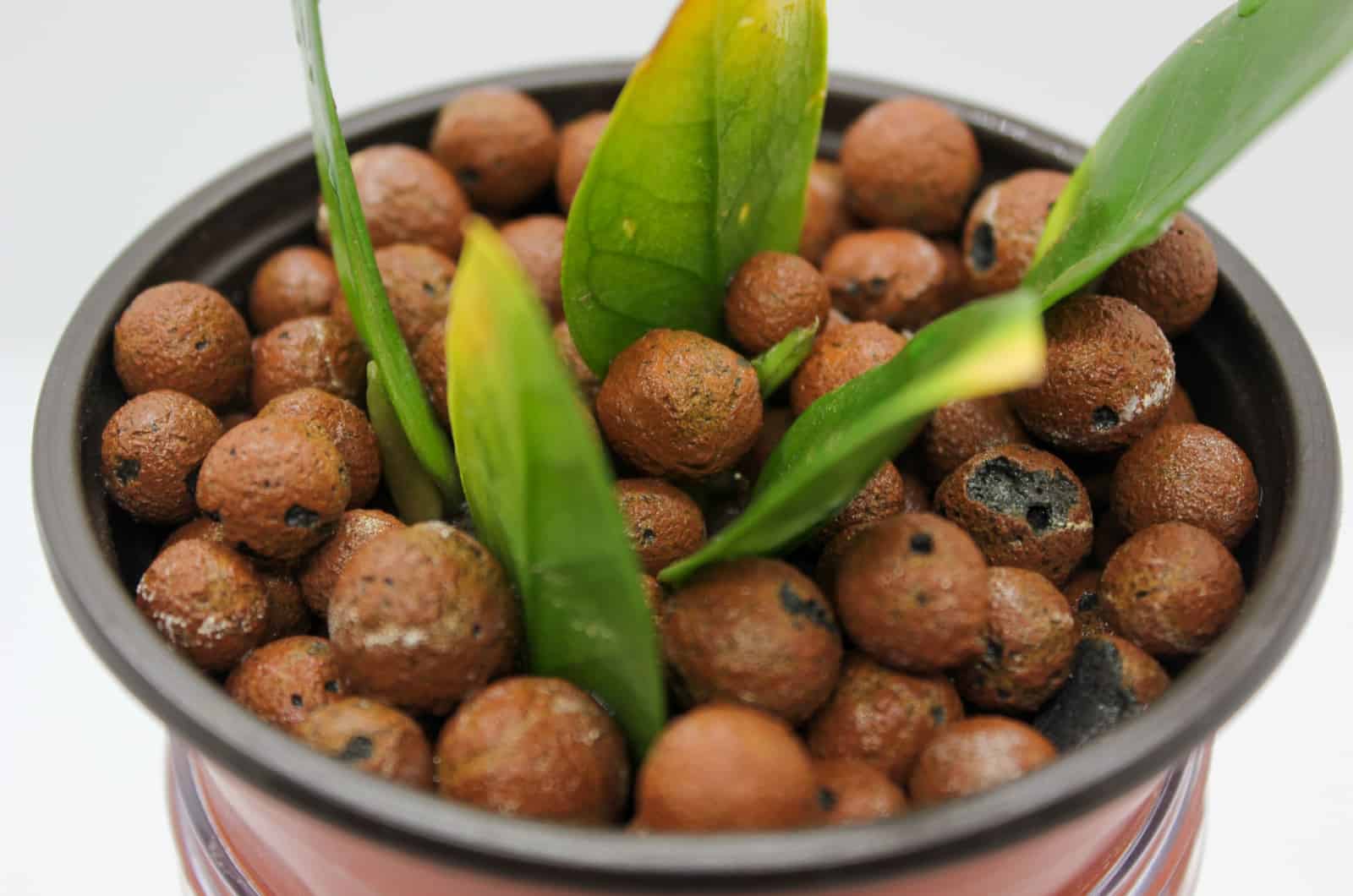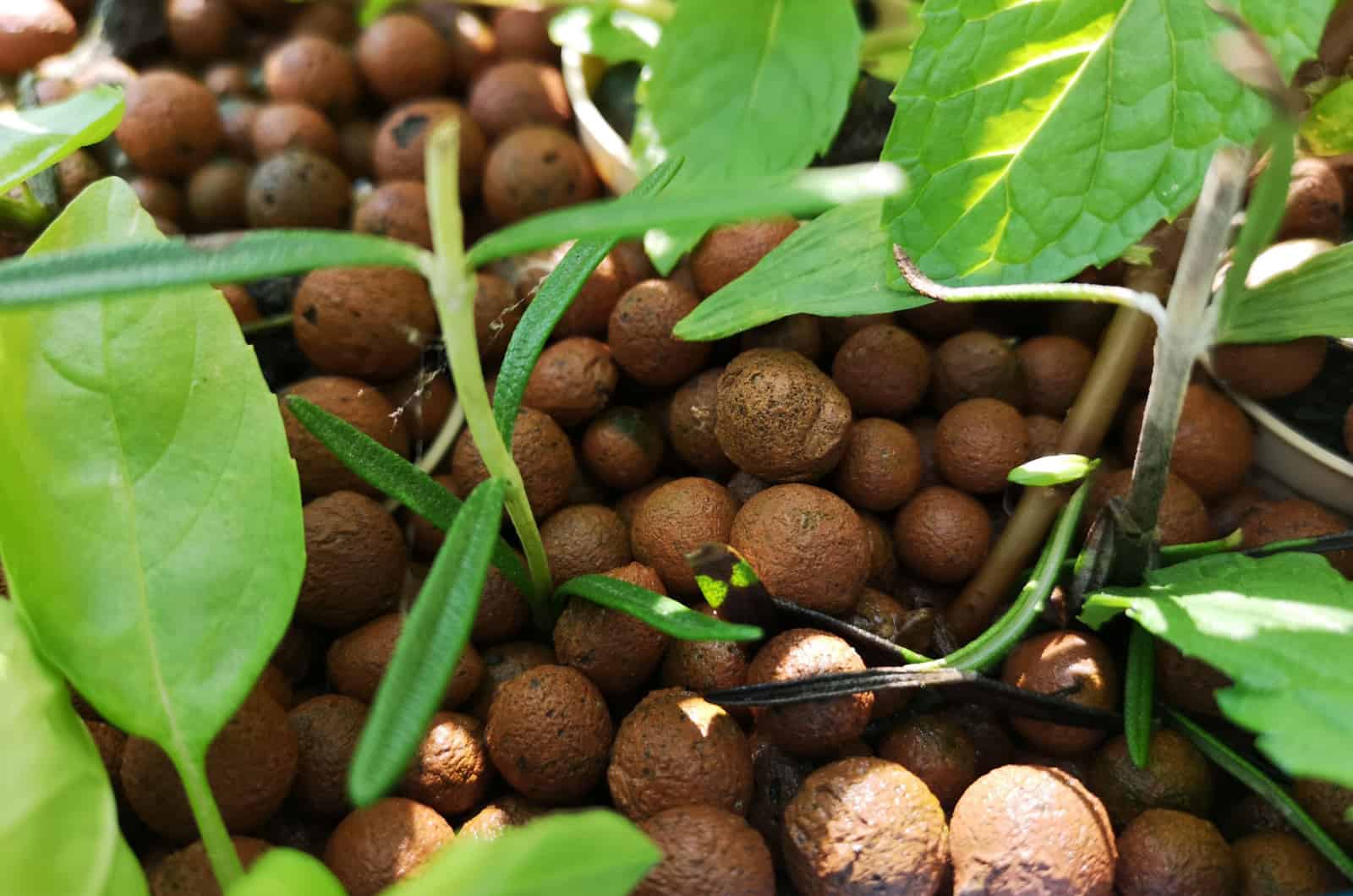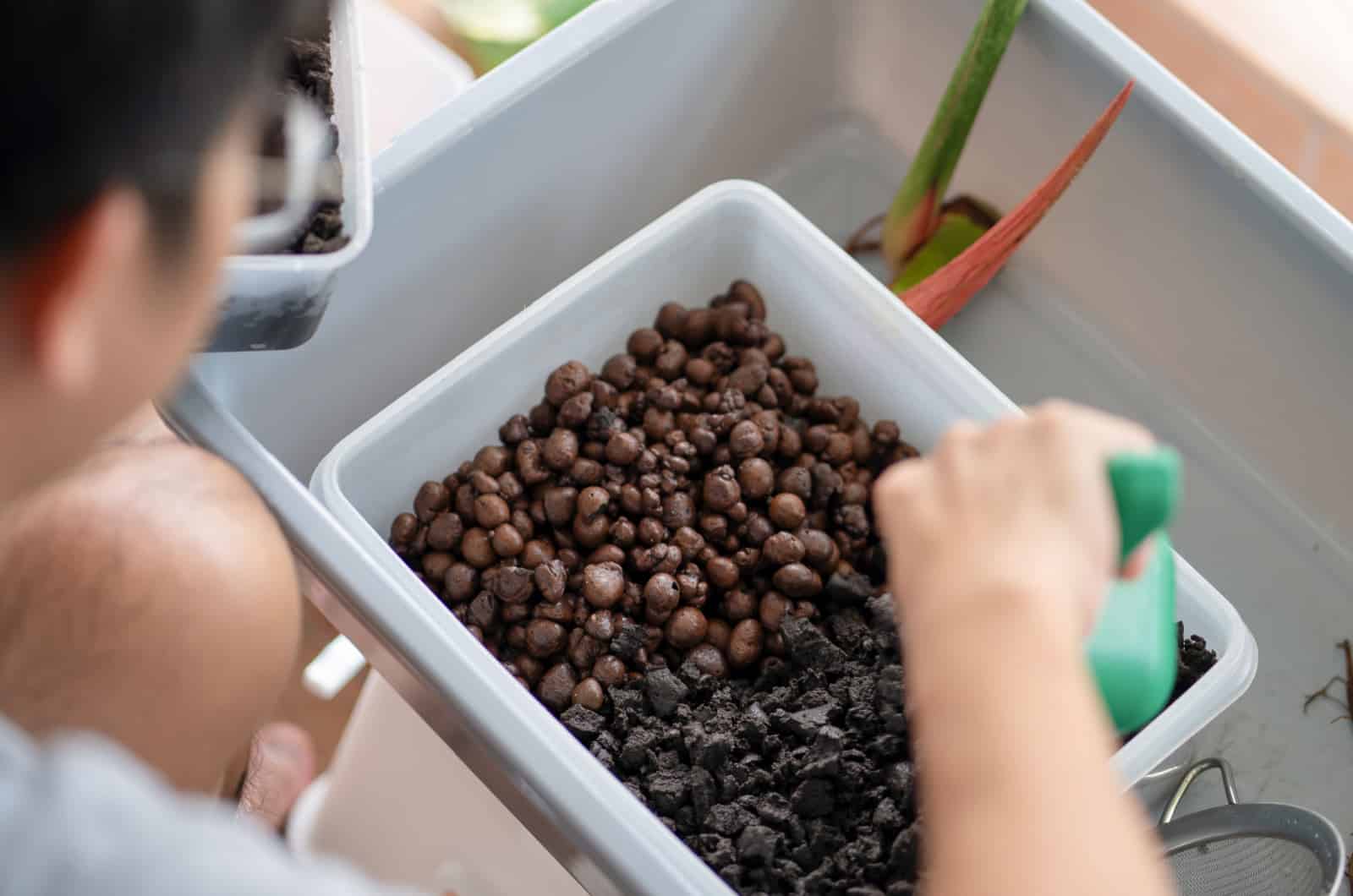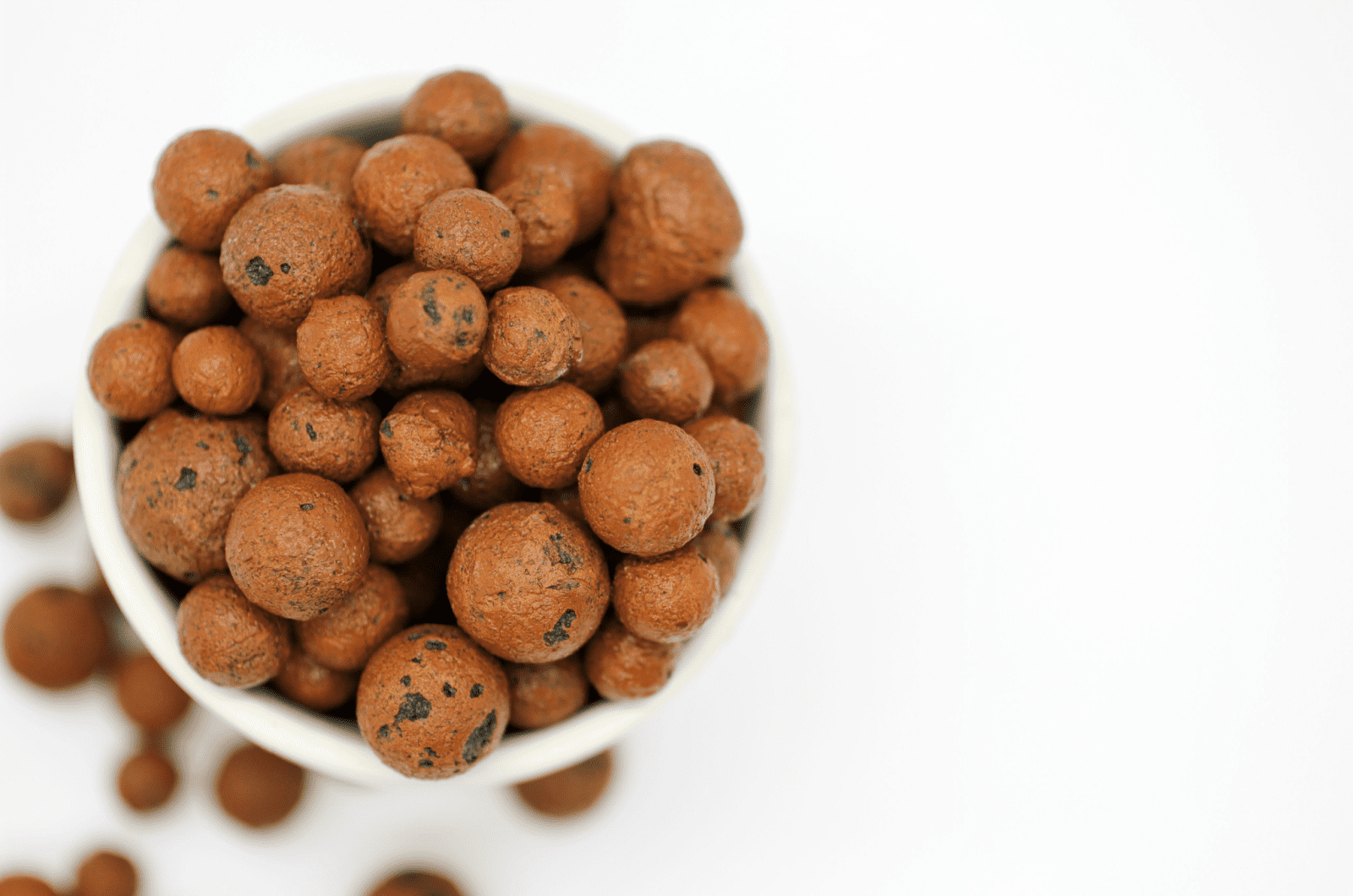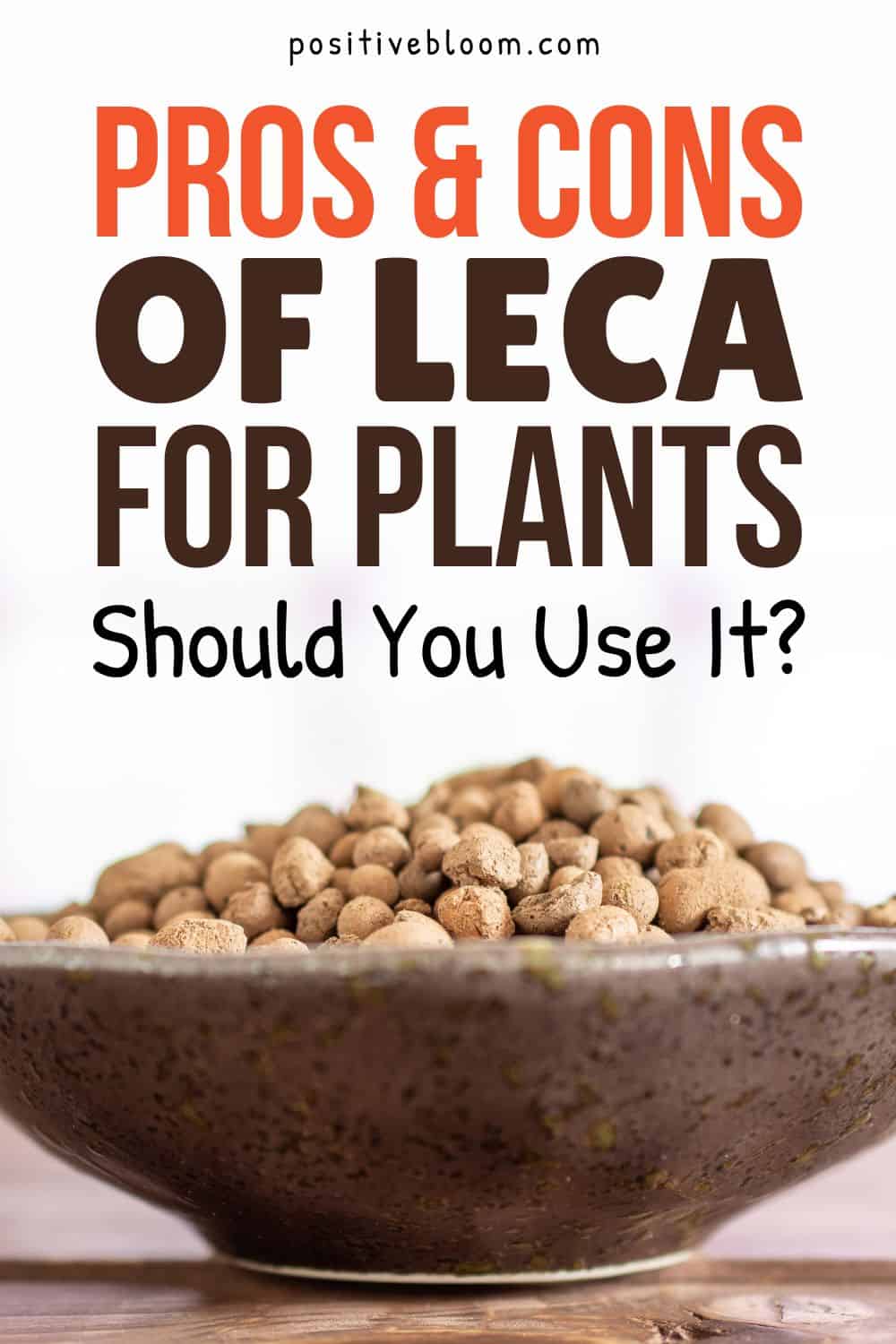LECA is not a gadget that astronauts use but rather an acronym that stands for “lightweight expanded clay aggregate”. But what is it exactly?
It’s actually a type of growing medium that you can plant your little green friends in. It is made by heating clay in a rotary kiln, which breaks and molds the material into numerous tiny balls. These expand and crack due to the heat, which leaves air pockets inside the pellets.
LECA balls, therefore, are a group of clay balls that have a porous surface and swell when you submerge them in water.
However, once you see how they look, you’ll have a lot of questions, I’m sure! How do you water plants with LECA? Can you fertilize them? How do you care for plants grown in this substrate?
We’ll tackle all these questions and more in the sections below and also examine some pros and cons of using LECA for plants so you can determine whether this medium is the right one for you.
Let’s get started!
Pros Of Using LECA For Plants
The first thought that comes to my mind when discussing LECA is how safe it is for plants. It provides much more aeration than traditional soil and soilless mixes, so your plant’s roots won’t be at risk of suffocating.
But could that be the only perk of this substrate? Of course not!
This medium makes plant care a walk in the park by reducing the risks of pest attacks and root rot, and you can even reuse it without worrying about the balls losing their shape.
For instance, if you’ve been wondering why your orchid is dying, it’s likely because of overwatering or underwatering, the wrong potting medium, pest infestation, etc.
Using LECA balls can significantly reduce the possibility of your plants dying because it ensures proper hydration and doesn’t contain any soil with organic matter that attracts insects.
We’ll talk about it more in the sections below!
Easier Plant Maintenance
One of the main attributes of LECA is that it soaks in moisture and slowly releases it to your plants. This means that you won’t have to water your plants as frequently and worry about whether or not you should irrigate them.
You just have to ensure that there’s always water in the pot for the LECA to absorb, and that’s it! Watering is out of the way, and you can focus on your plant’s other needs, like exposing it to the right amount of sunlight and fertilizer.
For instance, if you notice some discoloration on your plant’s foliage, you can discard under or overwatering as an issue and immediately question whether your plant is getting enough light.
When growing plants in soil, you won’t know whether the issue is water, light, fertilizer, or something else.
But because the water issue is taken care of when you grow plants in LECA, you can direct your focus on other causes, which makes caring for plants – even the more demanding ones – much easier.
Less Work
LECA balls soak in moisture that your plants use at their own pace, so you won’t have to put in too much work. It might take weeks for the water to be completely absorbed, which means you can concentrate on other things.
When you grow plants in potting soils and mixes, you’ll have to water them much more often (once a week or even more frequently), depending on your plants’ needs and the weather conditions where you live.
You’ll have to let the excess water drain through the holes in the bottom of the pot, which speeds up the drying of the soil, so you’ll have to irrigate your plants at least once a week during hot summers.
LECA can hold water much longer, and you’ll only have to add water once a month or even less if the temperatures aren’t too high.
Another perk of growing houseplants in LECA is that the water can evaporate more easily, so you won’t have to figure out creative ways of improving humidity around your plants, which instantly reduces the amount of work you have to put in.
Finally, LECA creates little-to-no mess.
Reduced Risk Of Pest Infestations
Using hydroton LECA pebbles reduces the risk of pest infestations simply because there’s no soil that can go bad from being wet too long.
When the potting mix rots, it takes the plant’s root system with it, which attracts all sorts of pests such as spider mites, fungus gnats, etc.
One of the great things about LECA clay pebbles is that they are inorganic, so there are no live organisms in them, and they won’t start rotting even though they are constantly soaked in water.
There are also pests that love dry environments, or rather environments with low humidity. Soil traps moisture within it, and because it cannot escape, the air around your plant is somewhat dry.
These insects love this sort of dryness, so if you want to avoid them, you should mist your plant’s foliage frequently, purchase a humidifier, or find some other way to increase humidity, like making a pebble tray.
LECA is not dense, and there are gaps between the clay pebbles that allow water to evaporate and humidify the air around your plant.
Reduced Risk Of Root Rot
LECA is ideal for beginners who have just gotten their first indoor plant. The risk of root rot is significantly reduced because you only water your plants when there’s no more fluid in the pot.
You don’t have to guess whether your plant could use some more moisture and accidentally overwater it.
For instance, there are many reasons your spider plant might be dying, but overwatering and root rot are the leading causes. Thankfully, you can avoid this by simply transferring your plant into LECA because the clay balls will absorb water and keep the roots of your plant safe from this horrible disease.
Another thing that contributes to a reduced risk of root rot is the fact that LECA pebbles create air pockets and aerate the plant, which provides much-needed oxygen.
Reusable
Finally, LECA balls are budget-friendly because they are reusable, and you can use them for many different types of plants, such as snake plants, alocasia, and pothos.
The good news is that you don’t have to completely change your plant care guide if you want to see root growth and plant development, simply adjust watering and feeding.
These clay pebbles can last a lifetime, but you have to clean them properly before planting a new plant in them because they may contain certain compounds, minerals, and elements that can hurt more delicate varieties.
Here are some tips that can help you clean LECA as quickly as possible:
On the other hand, you shouldn’t reuse the same soil for different plants because it could contain fertilizer salts and lead to mineral build-up if you feed the new plant. The old growing medium may also contain bugs and larvae, bacteria, and fungi, all of which may prove fatal to the new and young plant.
Cons Of Using LECA For Plants
Even though there are many pros to using LECA for plants, there are also some cons you need to consider before repotting all of your plants into this medium.
LECA is more expensive than regular soil, requires more preparation, and you’ll have restricted pot and fertilizer choices.
This section provides a detailed account of these cons so you can make an informed decision when the time for potting or repotting arrives.
Price
It’s no secret that LECA is more expensive than potting soil, and once you see a bill 3-4 times larger than it used to be, you might think twice about getting this medium!
However, it is more sustainable and budget-friendly in the long run because you can reuse it as much as you like. It also makes caring for orchids, sansevieria, philodendrons, etc., much easier and saves you time.
(At least you won’t feel like Proust when he created In Search of Lost Time.)
More Initial Work
So, here’s the thing! LECA reduces the amount of work you have to do for the plant in terms of watering, but you will have to prepare this substrate before using it.
It’s not like soil, which you can use straight out of the bag; LECA clay balls have to be washed thoroughly before using them for the first time.
It is quite a lot of work compared to soil, which doesn’t require any preparation at all.
Furthermore, LECA clay has a pH level of 7.0, which might lead you to believe that it is not suitable for acid-loving houseplants such as philodendrons, monsteras, succulents, or even hydroponics.
However, you can add some pH down to make the medium more acidic, but this is another extra chore.
Restricted Container Choices
If you have decided to switch from soil to LECA medium, I’m afraid I have more bad news for you.
Plants grown in potting soils usually require containers with drainage holes, so you might have a few of those lying around your house. Unfortunately, you’ll have to buy new ones because LECA medium needs pots that can hold water – so no potholes!
Sometimes this growing medium feels contradictory because here I am talking about pots that should have no drainage holes, and then I present the fact that you can use net pots with LECA!
These pots have large holes in their sides and are typically used for hydroponic gardening. You can fill them with LECA or some other soilless medium such as coco coir, gravel, sand, etc., and place them in a bubbler bucket filled with water.
Even though you have some options when choosing a container for LECA, you are still bound by the fact that none of your old pots will work, which is a huge drawback.
However, it is up to you to decide, and if you wish to start small and grow just one plant in this medium, it shouldn’t be too much of a bother.
Restricted Fertilizer Choices
LECA medium requires specific nutrient solutions because regular fertilizers need soil in order for the plant to use it.
Luckily, Amazon has a wide range of hydroponics fertilizers that are perfect for clay balls.
However, if you have some of your regular fertilizer left, you might feel unwilling to switch to semi-hydroponic nutrient solutions.
When To Use LECA For Plants
Now you know all the pros and cons of using LECA for plants, but we still haven’t discussed exactly when we should use it.
Can you just decide to move your plants from soil to a semi-hydro system one day? Or should you grow using semi-hydroponics from the very beginning?
Well, you’ll be glad to hear that both options are possible, but you will have to make certain amendments and ensure you do it properly.
Transferring Plants From Soil To LECA
It’s not difficult to move your plant from soil to hydro, but there are some steps you need to follow in order to give your plants the best fighting chance:
Step 1. Choose a see-through container made from glass or plastic so light can get through and reach your plant more efficiently.
Step 2. Carefully remove the plant from its current home, and remove the dirt and organic matter around its roots. Be gentle and try not to damage the roots, or else your plant will have a hard time adjusting and surviving.
Step 3. Wash out the remainder of the dirt under a slow stream of running water or by immersing the roots in a bowl of water. Try to get as much soil off as possible.
Step 4. Place the plant in a transparent vessel and fill it with LECA.
Step 5. Add some water and hydroponics fertilizer.
Pro tip: Don’t use tap water because it may contain too much chlorine, which can hurt your plants. If you don’t have any other source of moisture, leave some tap water out in the open air for a day so the chlorine can evaporate. There is such a thing as the best water for plants, so do some research and create the best environment possible for your green buddies.
Propagation In LECA
Propagation in LECA is quite beneficial because these clay pebbles help with air circulation. New roots can get more oxygen during their initial growth, which makes them less susceptible to transplant shock.
Here is a step-by-step guide to propagating plants in clay balls:
Step 1. Clean and soak the LECA pebbles and fill half of the container with them.
Step 2. Place the cutting into the LECA, add some more of these clay balls, and pour water until you fill half the vessel.
Step 3. Replenish the water whenever it completely absorbs and evaporates. You can also rinse LECA pebbles a bit before adding water.
Step 4. Place the container in a well-lit spot and wait until you see the new root system developing. You can either transplant the plant into soil or keep it in LECA once the roots become a bit stronger.
How To Use LECA Balls?
There are many plants that can thrive in soilless mixes, semi-hydro, and hydroponics systems. For instance, you can easily grow a lotus without soil – you just need to add material like gravel, LECA, or small stones to support the roots and add some hydroponics fertilizer.
But how exactly should LECA be used?
Well, you can’t use it straight out of the box, that’s for sure. You have to rinse it thoroughly (about half an hour should be fine) so that all the dust is washed away. You can do this outside and use a hose and a laundry mesh to reduce the mess.
After washing, you should soak LECA for about 48 hours in two intervals. Find a large container, fill it with water, and submerge the LECA pebbles in it. After 24 hours, replace the water and leave the balls to soak for another day.
You can always save these balls for later if you don’t want to use them right away. Simply let them dry and store them somewhere before usage.
Many gardeners like to include a third soak for their LECA, while some even drench this material in water for about two weeks before using them. There’s nothing wrong with this method, and it certainly won’t damage the balls.
LECA always needs to be wet and never dry when you plan on growing or propagating plants in it.
You can also add some calcium and magnesium when soaking to provide the best possible environment for your plants.
Finally, you can boil LECA after the second soak just to make sure it is completely sterile. However, it’s usually not necessary, and you can skip this step if you find it bothersome.
FAQ
LECA is an interesting material, so it’s not surprising that there are so many questions about it.
We couldn’t possibly answer all of them in just one article, but we chose some of the most frequent that you asked us and will answer them in the sections below.
What is the best time to transplant a plant to LECA?
A general rule for repotting new plants in LECA is to wait until the growing season of your plant starts because that’s when it has the biggest chance of success.
When repotting, you should always water your plant a couple of days before transplanting before thoroughly rinsing the roots with water and leaving them to dry.
Can you use LECA for all plants?
No, you shouldn’t use LECA for all plants because not all varieties have the same needs. For instance, some plants need aeration, and that’s when LECA comes in handy, but that same aeration can disrupt the balance of other plants.
There are also plants that need plenty of nutrients, but not all of them can absorb them from water that well. Therefore, growing certain houseplants in soil mixes is a great idea – you just have to research your plant’s needs and preferences before deciding upon a medium.
Should you mix LECA with soil?
There’s no problem mixing LECA with soil. It can only improve drainage, aeration, and moisture retention, which is why it can be quite beneficial for most indoor plants.
But because this material is quite pricey, we usually find other ways to make the soil well-draining, aerated, and water-retentive.
You can add perlite, pumice, vermiculite, sphagnum peat moss, horticultural charcoal, coco coir, orchid bark, and many other materials to make the soil perfect for your houseplants.
Wrapping Up
Using LECA for plants has its advantages and disadvantages, and it is up to you to decide whether it’s really worth it.
It makes caring for your plants easier and quicker because you don’t have to water them very often. It also reduces the risk of pest infestation and root rot and can last for a really long time, so you can clean it and reuse it for other plants.
However, it is more expensive than soil, it requires special pots and fertilizers, and you need to prepare it before using it.
We also included some tips on when and how you should use LECA in case you want to try growing a monstera or pothos in it.
Don’t be afraid to try out new things. Who knows, perhaps your plants will like it!
Good luck and until next time!
Like this post? Share or pin it for later!

